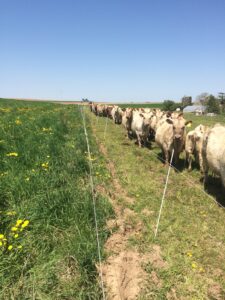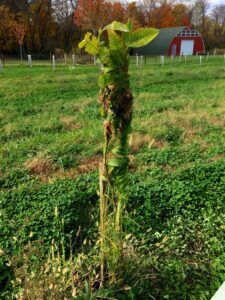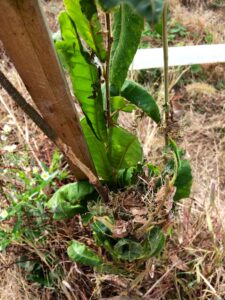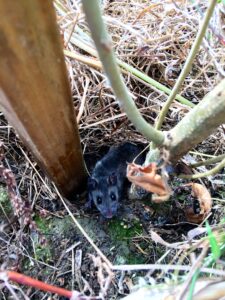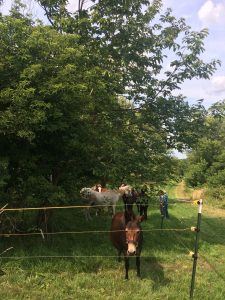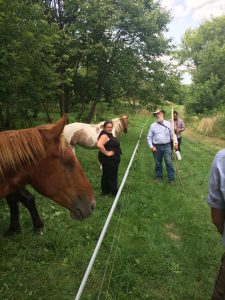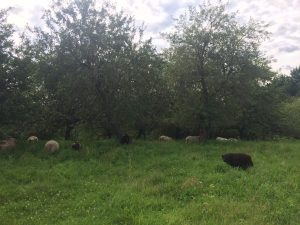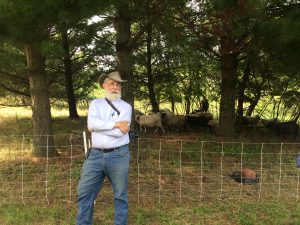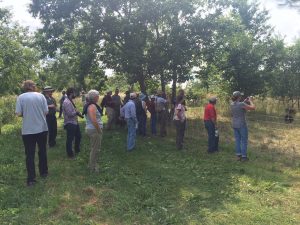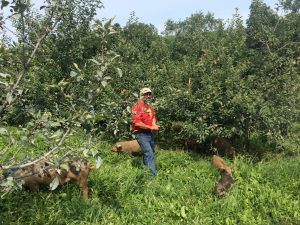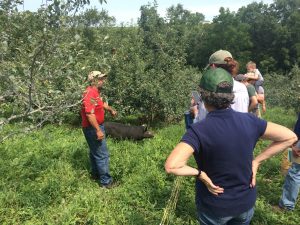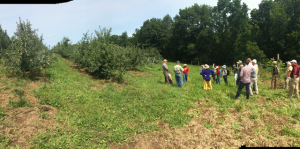Final report for ONC16-017
Project Information
Silvopasture – the integration of livestock, forage, and trees – can generate multiple high-value products with minimal off-farm inputs while enhancing ecological functions. Silvopasture remains largely untested in the Midwest US. To fill knowledge gaps faced by farmers in this region, we tested techniques of integrating livestock with seedling trees in pastures. Our trials on four farms in Wisconsin, Illinois, and Indiana including various types of livestock compared efficacy of different techniques for mitigating livestock and wildlife damage to trees, as well as potential competition from nearby herbaceous vegetation. We also conducted semi-structured exit interviews with participating farmers to document their qualitative assessment of strategies to establish and manage trees planted in pastures.
Effective methods for protecting seedling trees in silvopasture varied based livestock species as well as some environmental factors. Little to no protection was needed for pastured poultry, especially chickens. Wire cages most effectively prevented damage from larger livestock, but this method also was the most expensive and may be cost-prohibitive when trying to protect many trees. For large-scale silvopasture establishment, a combination of electric fencing with tree tubes works well for protecting the trees from damage while allowing livestock grazing to help manage competing vegetation. Tubes, alone, can be effective at protecting tree seedlings from sheep, provided that stakes are sufficiently sturdy.
Farmer-researchers reported general satisfaction with their silvopasture establishment. They have maintained their trial areas and in all cases either adopted more effective techniques learned in the course of the project and/or expanded silvopasture acreage. Outreach efforts made information gained through the research available in a several ways: field days at participating farms; conference presentations and webinars by farmers and ag professional; public release of recorded interviews between beginning silvopasturists and experienced practitioners; and improving network connectivity and availability of educational resources on the web. A manuscript of the research is also in preparation for a peer-reviewed scientific journal in order to share our findings with academic audiences.
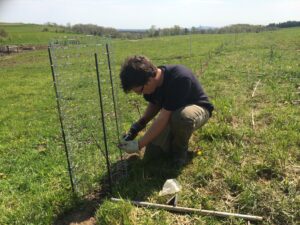
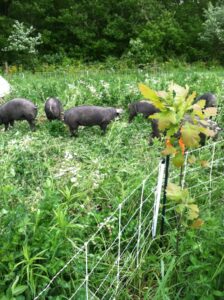
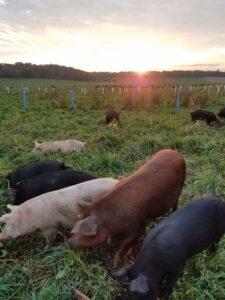
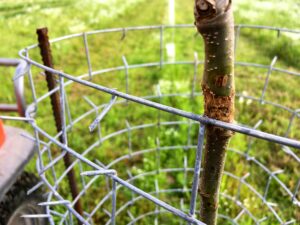
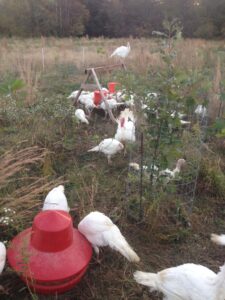
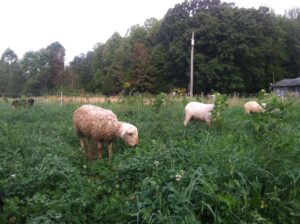
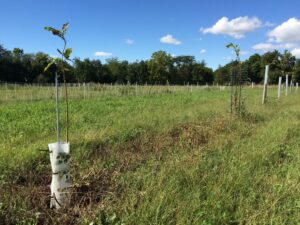
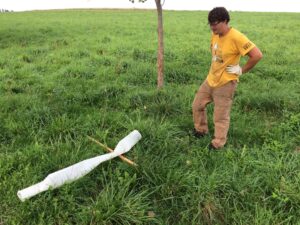
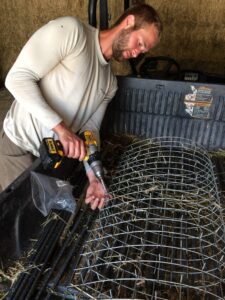
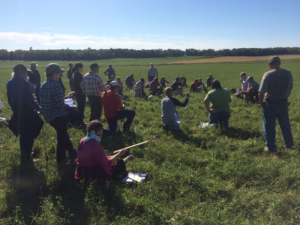
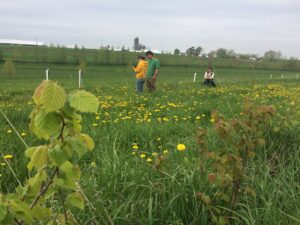
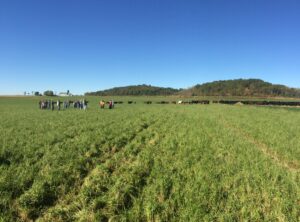
Single-strand electric fencing protects newly planted tree seedlings at Driftless Pastures, WI.
Rodent nesting in tree tubes was sometimes a problem at Seven Sisters Farm, IL.
Silvopasture for horses and sheep with nut, apple, and pine canopy trees at Badgersett Research Farm, MN.
Hog silvopasture with apple trees at Hoch Orchard, MN.
- Perform replicated trials of fencing and tree protection strategies in seedling-stage silvopastures on four farms, each integrating different species of livestock
- Track costs and required labor of establishing and managing seedling-stage silvopastures
- Record interviews and publish podcasts of conversations between beginning graziers and experienced silvopastoralists about best practices in establishing and managing silvopastures.
- Develop an online silvopasture hub for knowledge exchange within a map-based network of perennial agriculture practitioners, researchers, and educators
- Share research results via silvopasture hub, field days, conference presentation, and a bulletin
- Provide on-farm demonstration of effective silvopasture establishment techniques to field day attendees.
Cooperators
Research
Participating Farms
In 2015, four farms each established silvopasture by planting a diverse selection of seedling trees for fruit and nut crops, timber, forage, shade, and shelter (Table 1, Figure 1). Two farms planted trees into existing pasture/hay, and two farms planted trees contemporaneously with converting row crop fields to permanent pasture.
Nightfall Farm
Elizabeth and Nathan Brownlee own Nightfall Farms in Jennings County, Indiana, where they raise sheep, hogs, chicken, and turkey on pasture. All Nightfall Farm livestock consume GMO-free feed, except for sheep, which are 100% grass/pasture fed. The Brownlees rotationally graze, moving sheep once daily, chickens twice daily, hogs every 2-4 days, and turkeys every 6 days. Meat from their farm is sold locally through farmers markets, a 45-family CSA, and a chef. They decided to incorporate silvopasture into their grazing plan to help mitigate heat and drought effects on the livestock. In 2015, they established 5 acres of silvopasture and also raised 11 hogs, 1200 chickens, 7 lambs, and 110 turkeys. They planted more silvopasture in 2016 and raised 17 hogs, 1600 broiler chickens, 45 laying hens, 13 lambs, and 100 turkeys.
Driftless Pastures
Michael Dolan owns Driftless Pastures in Iowa County, Wisconsin. He established trees in 70 acres of pasture in 2015 and raised 30 grass-fed steers and 300 pastured broiler chickens. The silvopasture was interplanted more densely in 2016. Driftless Pastures is part of a larger farm (Seven Seeds Farm), which has ~7,000 fruit and nut trees on 70 acres of pastures used by cattle, hogs, chickens, and ducks. One reason Dolan planted silvopasture on Driftless Pastures is because it mimics the natural ecosystem and will improve the atmosphere, environment, and health.
Green Fire Farm
Jacob Marty co-owns Green Fire Farm in Green County, Wisconsin, where he raises cattle, hogs, turkeys, and chickens on pasture. He planted two acres in silvopasture in 2015 with about 300 fruit and nut trees including chestnuts, persimmons, pecans, and redbud. In 2016, he planted 1000 more fruit shrubs and pollinator habitat adding 10 more acres to the silvopasture, which included 800 currants and 900 trees. The trees are intended to provide forage for livestock as well as aesthetic value. Marty planted redbud, apple, and pear trees in a modified keyline contour pattern with 45 foot spacing between rows, after using a tree planter to create a furrow. He also used an arbuscular mycorrhizae dip.
Seven Sisters Farm
Cathe Capel owns Seven Sisters Farm in Champaign County, Illinois and raises sheep and poultry. In 2015, Cathe established 10 acres of perennial polyculture and alley cropping, including silvopasture where Capel’s sheep graze in the alleys. Tree crops grown on the farm include 254 species and 559 varieties, some of which are chestnuts, juneberries, serviceberries, currants, gooseberries, and hybrid hazelnuts. Capel wanted to establish silvopasture to help restore some of her acreage to a sustainable system that provides ecological services to the local watershed and provide fruit and nuts for the family and a small surplus to sell.
Table 1. Farms participating in silvopasture establishment study in Midwest USA and features of the experiment conducted at each farm respectively.
| Farm and location | Silvopasture established | Livestock | Trees in trial | Tree protection methods in trial |
| Elizabeth Brownlee | 10 acres in 2015 into existing pasture | Sheep, hogs, chickens, turkeys | Ash, bald cypress, hickory, oak, persimmon, willow, pecan, hazelnut, | · Homemade wire cages |
| Nightfall Farm | · Electric net fencing | |||
| Jennings County, IN | · 5’ Tree Pro Miracle tubes | |||
| Cathe Capel | 10 acres in 2015 into existing pasture | Sheep | Chestnut | · 5’ Tree Pro Miracle tubes |
| Seven Sisters Farm | · 4’ Tree Pro Miracle tubes | |||
| Champaign County, IL | · 18” Tree Pro Bark tubes | |||
| · Arbor Shield wire cages | ||||
| Michael Dolan | 70 acres in 2015 into new pasture; interplanted more densely in 2016 | Cattle | Apple, cherry | · Poly single strand fencing |
| Seven Seeds Farm | · 5’ Tree Pro Miracle tubes | |||
| Iowa County, WI | · Arbor Shield wire cages | |||
| Jacob Marty | 2 acres in 2015 into new pasture; | Hogs, sheep | Apple, chestnut, pecan, plum, basswood | · 5’ Tree Pro Miracle tubes |
| Green Fire Farm | 10 additional acres in 2016 | · Blue-X tree tubes | ||
| Green County, WI | · Arbor Shield wire cages | |||
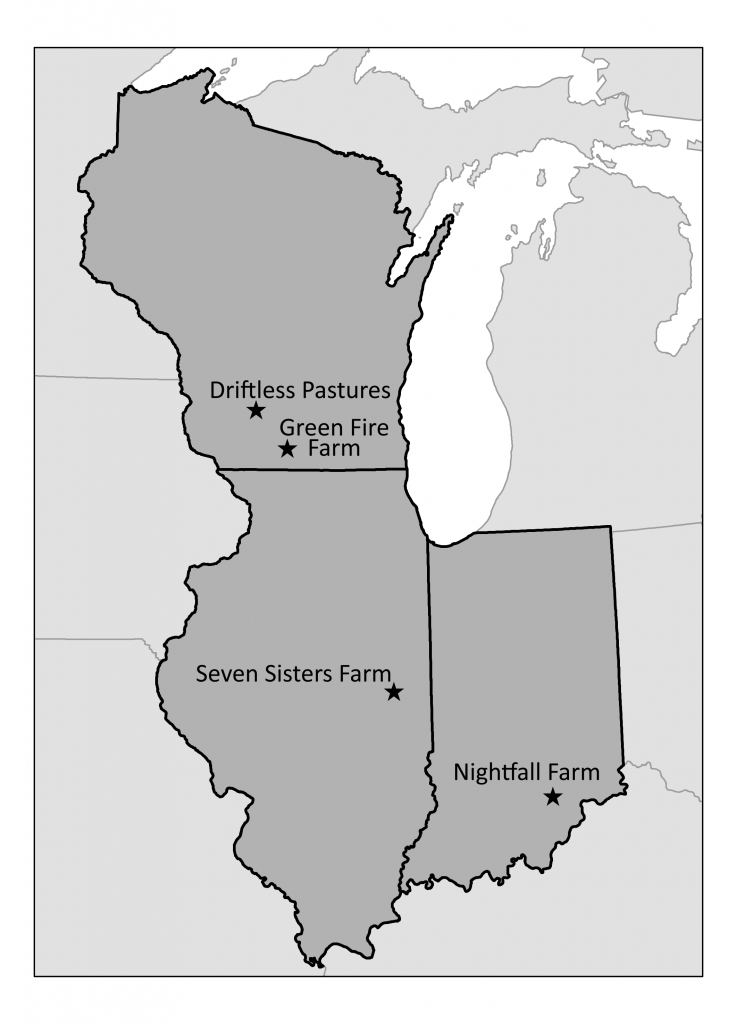
Figure 1. Locations of four farms participating in study.
Study Design
Each farm tested at least two of the following treatments against a no-protection control:
- portable single-strand electric fencing
- portable net electric fencing
- polyethylene tubes
- steel wire cages
Each treatment was replicated at least twice on each farm and measurements were taken on a standard number of trees/replicate (Table 2). Treatment locations at each farm were assigned randomly except on Nightfall Farm due to practical constraints. Some farms tested multiple models of polyethylene tree tubes. Farms conducted tests with one or more livestock species, including cattle, sheep, hogs, chickens, and turkeys. This study design allowed comparison of treatments and livestock species within farms as well as contrasting findings among farms as distinct experiments.
On each farm, we made measurements on seedling trees and adjacent vegetation (referred to as weeds due to potential competition with trees) before and after at least one grazing event in 2016 and 2017, although some treatments were discontinued in 2017. Browse and livestock damage to trees were recorded on a categorical scale: heavy, some, or no damage. Height of trees was measured, as well as weed height at 0, 0.3, and 1m from tree, with the exception of Seven Sisters Farm, where weed heights were not recorded. Weed cover was also recorded within 0.3m of the tree and 1m of the tree, respectively, as heavy, some, or none, but these data were not recorded consistently and are not reported.
Table 2: Data collection at farm trials recorded level of browse damage and competing vegetation on seedling trees assigned different protection treatments following a protocol including the parameters as shown here.
|
Before or After Livestock |
Protection Treatment |
Live-stock |
Tree Species |
Browsed or damaged |
Tree Height |
Weed height at tree |
Weed height @ 30cm |
Weed height @ 1m |
Weed cover 30cm |
Weed cover 1m |
|
B-Before or A-After Rotation |
Drop down menu |
Drop down menu |
Drop down menu |
H-Heavy S-Some N-None |
Record in cm |
Record in cm |
Record in cm |
Record in cm |
H-Heavy S-Some N-None |
H-Heavy S-Some N-None |
We conducted semi-structured exit interviews with each participating farmer to document their qualitative assessment of techniques tested to establish pasture trees on their respective farms. Interviews discussed objectives and approaches for planting trees, and lessons learned about combinations of livestock, trees, protection techniques, paddock layout, and management.
Materials
Materials used for the on-farm trials of pasture tree seedling establishment methods included:
- electric net fence (~$130/164’; ElectroNet 9/35/12 Electric Netting, Premier 1 Supplies, Washington, IA, USA )
- polyethylene single-strand electric fence (~$36/660’; 1/16” Poly Wire, Gallagher, Oswego, IL, USA)
- electric fence energizer ($200)
- pig-tail posts (~$4 each)
- t-posts for temporary corners (~$5 each)
- 2’, 4’ and 5’ Tree Pro brand polyethylene tube tree protectors ($0.90 Bark Pro, $3.35 and $4.05 Miracle Tubes, Tree Pro Inc, West Lafayette, Indiana, USA)
- Blue-X TreeShelter polyethylene sleeves ($4.00 each, Blue-X Enterprises, Inc., Sacramento, CA, USA)
- Arbor Shield steel wire cages ($29.77 each, Cobacha LLC, New York, NY, USA)
- materials for homemade steel wire cages ($10.64 each, custom cut 8’x4’ welded steel wire panels, ½” diameter steel rebar)
Analysis
Each livestock species within each farm was analyzed independently as a separate experiment. Tests for differences among treatments were limited to data collected after grazing events. Differences in response means among treatments were determined by one-way ANOVA, with pairwise differences tested via Tukey HSD or Tukey-Kramer post hoc analysis. In some experiments, treatments were mulched and weed heights were artificially kept at 0 cm. In these cases, t-tests were performed on the remaining two treatments with grazing data. Data were analyzed using SYSTAT 10 (San Jose, CA). Presence/absence data for Seven Sisters Farm tree damage data was analyzed using Pearson’s chi square test. Significant differences are reported at p < 0.05. Box plot figures were made using an inclusive mean.
Nightfall Farm
Tree heights sustained little to no reduction regardless of treatment or livestock type (Figure 2). However, browsing damage by sheep was significantly higher on unprotected trees compared to all other treatments (F2, 89 = 46.45, p < 0.0001; Table 3). In fact, after the first grazing season, 90% of the unprotected trees were heavily damaged after sheep grazing. By the end of the second grazing season, only a quarter of the unprotected trees sustained little-to-no damage, and over 50% of the trees were heavily browsed. Most of this damage was attributable to sheep and very little to chickens Figure 2). Trees protected by wire cages were significantly taller compared to those protected by electric net fence for sheep (F3, 89 = 3.44, p = 0.02) and unprotected trees for poultry (F3, 84 = 3.25, p = 0.03; Figures 2, 3).
Table 3: Browsing damage by visual estimate index after grazing by sheep and poultry for each protection treatment at Nightfall Farm. Index classifications were 1: little to no browsing damage (0-33% foliage removed), 2: moderate browsing damage (34-66% foliage removed), 3: heavy browsing damage (67-100% foliage removed), and 4: dead. Means within livestock not sharing a letter are significantly different (Tukey-Kramer p < 0.05).
|
Livestock |
Treatment |
n |
Damage (±variance) |
|
Sheep |
No protection |
20 |
2.8 (±0.4)a |
|
Electric net fencing |
30 |
1.1 (±0.3)b |
|
|
5’ Tree Pro tree tubes |
22 |
1.2 (±0.3)b |
|
|
Homemade wire cages |
21 |
1.2 (±0.2)b |
|
|
Poultry |
No protection |
25 |
1.1 (±0.4)a |
|
Electric net fencing |
20 |
1.2 (±0.5)a |
|
|
5’ Tree Pro tree tubes |
22 |
1.2 (±0.3)a |
|
|
Homemade wire cages |
21 |
1.4 (±0.5)a |
Weed pressure, as measured by weed height at 0, 0.3, and 1 m from trees, was reduced by both sheep and poultry in treatments where weeds were not kept artificially low by bagging/mulching (i.e., wire cages and electric net fencing, Figure 2). Post-grazing, weed height was greatest near trees protected by tree tubes, with the most substantial decrease occurring closest to the tree (Figure 2). Weed heights in the unprotected paddock showed the opposite trend—that is no height reduction was detected after sheep grazing at 0 cm from the unprotected trees in 2016. Sheep may have found the tree leaves more palatable compared to the surrounding pasture, and therefore preferentially browsed the trees rather than grazing on surrounding forage. In treatments that were mulched within 30 cm, sheep grazing and poultry grazing decreased weed heights at 1m, except for the electric net fencing in 2016.
Weed height patterns after poultry grazing were different than for sheep. Weed heights were most reduced for unprotected trees grazed by chickens and for trees protected by Tree Pro Miracle Tubes by turkey (Figure 2). Given that chickens caused little to no browsing damage to trees, and the weed heights surrounding these trees decreased, tree protection treatments may not be necessary when establishing silvopasture with poultry.
Of the trees in the control plots, oak, persimmon, and willow were more likely to be damaged after a grazing event compared to hickory and cypress (Table 4). Ash fared the best and were least likely to be damaged by sheep grazing. Oak and persimmon were the tallest at the end of the second year (153 cm) in the wire cage treatment, followed by the electric net fence, and were shortest in the control. The tube data cannot be compared as they originally had sheep grazing exclusively hazelnuts, but sheep became ill during their time in this paddock, so those test plots were abandoned.
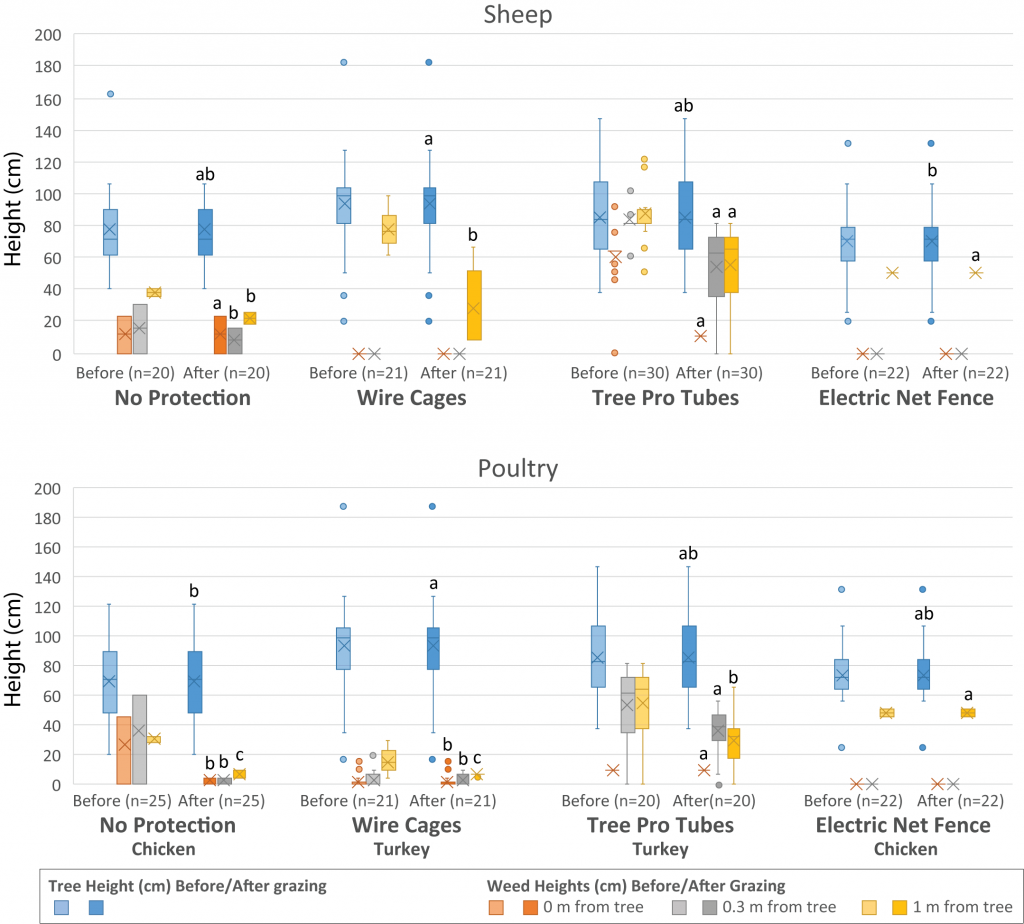
Figure 2: Tree height and weed height before and after sheep and poultry grazing for tree protection treatments at Nightfall Farm in 2016. Weed heights were measured at 0, 0.3, and 1 m from tree. Tree protection treatments included a no protection control, homemade wire cages, 5’ Tree Pro Miracle Tubes, and electric net fencing. Treatment means that share a letter were not significantly different (one-way ANOVA with Tukey-Kramer post-hoc analysis or t-tests at p < 0.05). Mulched treatments were excluded from statistical analysis.
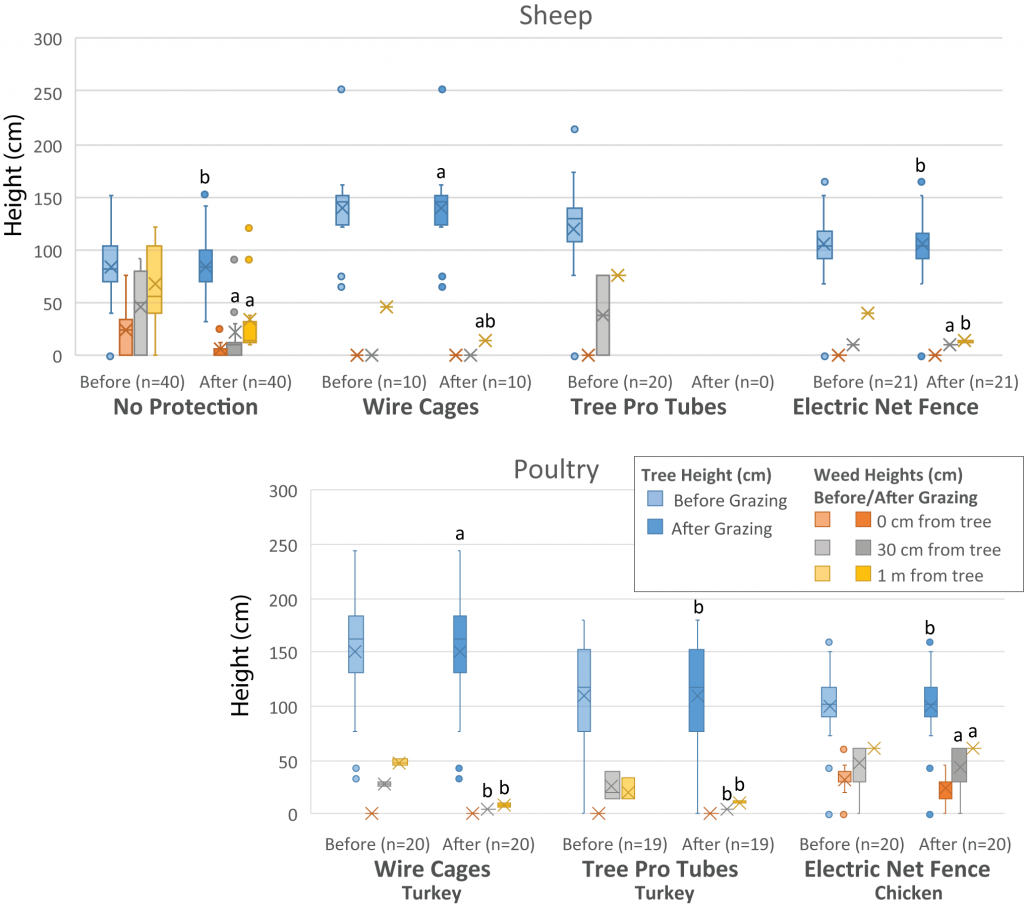
Figure 3: Tree height and weed height before and after sheep and poultry grazing for tree protection treatments at Nightfall Farm in 2017. Weed heights were measured at 0, 0.3, and 1 m from tree. Tree protection treatments included a no protection control, homemade wire cages, 5’ Tree Pro Miracle Tubes, and electric net fencing. Treatment means that share a letter were not significantly different (one-way ANOVA with Tukey-Kramer post-hoc analysis or t-tests at p < 0.05). Mulched treatments were excluded from statistical analysis. Note sheep grazing experiments were discontinued in the Tree Pro Tube treatments due to sheep illness.
Table 4: Height and damage to trees before and after grazing events by tree sheep during 2016 at Nightfall Farm.
|
|
|
Before |
After |
||||||
|
Height (cm) |
None |
Some |
Heavy |
Dead |
None |
Some |
Heavy |
Dead |
|
|
Oak |
76.8 |
9 |
0 |
0 |
0 |
5 |
0 |
4 |
0 |
|
Persimmon |
72.0 |
19 |
0 |
0 |
4 |
13 |
0 |
10 |
0 |
|
Ash |
123.2 |
2 |
0 |
0 |
0 |
2 |
0 |
0 |
0 |
|
Hickory |
55.0 |
3 |
0 |
0 |
0 |
3 |
0 |
0 |
0 |
|
Willow |
54.9 |
5 |
0 |
0 |
0 |
1 |
0 |
3 |
1 |
|
Bald Cypress |
88.1 |
3 |
0 |
0 |
0 |
2 |
0 |
1 |
0 |
Farmer observations
Wire cages worked the best for protecting the trees from livestock, and after two additional grazing seasons have passed, the trees were twice as tall as trees in other treatments. However, it is difficult to attribute all the growth difference to the protection treatments—site characteristics likely play a large role in tree height. Tree species seems to play little role in the differences. It is unclear how much browsing or treatments specifically affected tree heights.
After sheep grazed the establishing silvopastures, trees were often stripped of leaves, at least partially; however, they almost always bounced back. It is unclear whether sheep browsing slowed down tree growth or stimulated growth in the long-term. Overall, success of the trees may not have been influenced greatly by livestock type or protection treatment because the site quality was so different for each of the treatments. Northern sites (no protection treatments) were more clay-rich and tended to have water issues; whereas tree tube and wire cage treatments were on better sites.
Sheep loved rubbing on the tree tubes, and would often bend some of the tubes/trees in half, or completely knock the trees down. They typically tended to focus their rubbing on a few trees/tubes, leaving the rest standing. Sheep illness after the first year led to the abandonment of sheep grazing in the tube protection treatment pastures. The trees growing in these pastures were exclusively hazelnut; however, it is unlikely hazelnut browsing sickened the sheep. A veterinarian treating the sheep believed the illness was a result of forage diet—the initial pasture planting did not take well and was far weedier than other treatment plots. Also, the tree tube pastures were in a narrow strip of land leading to a wetland and flooded once during the study.
Although not in the study, hogs were also grazed in establishing silvopasture at Nightfall Farm. In general, hog grazing was problematic for unprotected trees—especially species like persimmon. Sycamores and cottonwoods tended to hold up much better, including to rooting.
The amount of forage available in pastures exceeded the capacity of livestock to graze it; thus, some alternative weed management practices were employed. Once a year, usually in the spring, old paper feed bags were laid down near trees with overlying mulch to keep the weeds down. Sometimes the weeds were mowed before they were bagged/mulched. Pastures were grazed twice a year, resulting in tall pastures with many plant species. Because of this, tall forage tended to shade out nearby pasture, leading to many areas of bare soil and clumps of forage. The bare soil spots were good for the poultry to dust themselves and during high temperature days and they provided cool spots for larger livestock to lay down. Since the pastures were not uniform coverage/height to begin with, it was sometimes difficult to assess and record an average weed coverage/height with distance from the trees.
Overall, the trees are doing well and the Brownlees are happy with their silvopasture progress—the trees are starting to be noticeable from the road. They are happy that that the silvopasture is fulfilling their goals and it is not much effort to maintain after the initial planting was done. If they could change one thing, they would not have planted trees in low-lying furrows left by the previous tenants. Although the trees are surviving, this area is more likely to experience water logging, and would likely do better if planted just a foot to the side of the furrow.
Driftless Pastures
The farmer grazed cattle in a paddock with unprotected trees as well as paddocks with the following tree protection treatments: Arbor Shield wire cages, Tree Pro Miracle Tubes, and single-strand electric fencing. Cages were most effective at protecting trees from damage (F3, 76 = 58.9, p < 0.0001; Table 5). Single-strand electric fencing was also significantly better than tree tubes and no protection treatments at reducing browsing damage from cattle (Table 5). Notably, some of the damage sustained on unprotected trees and trees protected by tubes included reduction in tree height after cattle grazing (Figure 4).
Following grazing, weed heights within 1m of trees protected by single-strand electric fencing were significantly higher than all other treatments (Figure 4) as the single-strand fencing was set at a distance of 30-60 cm from the trees. It is unclear why weeds 1m from the trees were not reduced more post grazing. For all other treatments, weed height within a meter of the trees was relatively well controlled by grazing events with the exception of 0 cm distance from trees protected by wire cages (Figures 4, 5). For trees protected by wire cages, weed heights 0 cm from the trees increased post grazing since cattle were not able to access vegetation within and immediately adjacent to the cages.
Table 5: Browsing damage by visual estimate index after grazing by cattle for each protection treatment at Driftless Pastures in 2016. Index classifications were 1: little to no browsing damage (0-33% foliage removed), 2: moderate browsing damage (34-66% foliage removed), 3: high browsing damage (67-100% foliage removed), and 4: dead. Means not sharing a letter are significantly different (Tukey-Kramer p < 0.05).
|
Treatment |
n |
Damage (±variance) |
|
No protection |
20 |
2.50 (±0.26)a |
|
Arbor Shield cages |
20 |
1.05 (±0.05)c |
|
5’ Tree Pro tree tubes |
20 |
2.65 (±0.24)a |
|
Single-strand electric |
20 |
1.50 (±0.26)b |
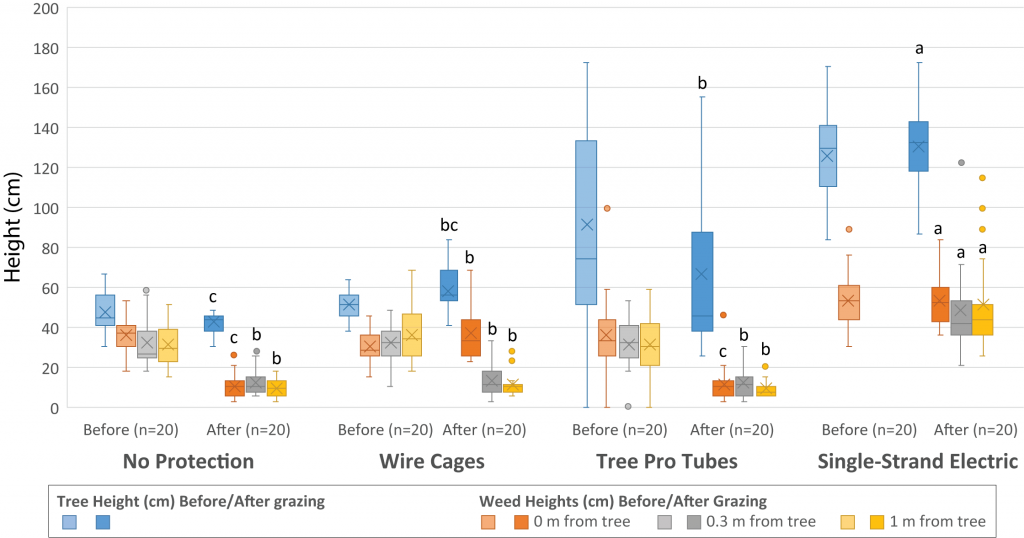
Figure 4: Tree height and weed height before and after cattle grazing for tree protection treatments at Driftless Pastures in 2016. Weed heights were measured at 0, 0.3, and 1 m from tree. Tree protection treatments included a no protection control, Arbor Shield wire cages, 5’ Tree Pro tree tubes, and single-strand electric fencing. Response means that share a letter were not significantly different (one-way ANOVA with Tukey-Kramer post-hoc analysis at p < 0.05).
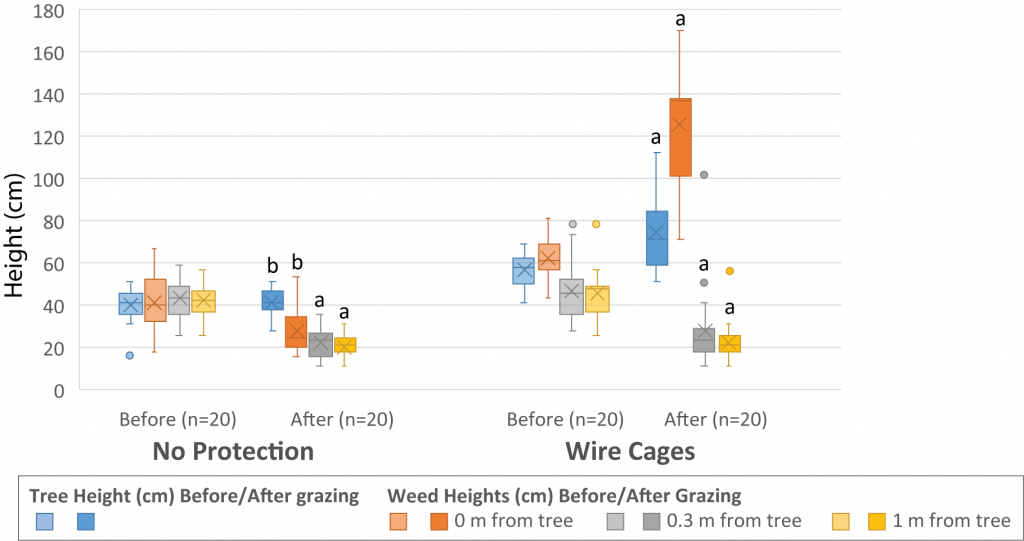
Figure 5: Tree height and weed height before and after cattle grazing for tree protection treatments at Driftless Pastures in 2017. Weed heights were measured at 0, 0.3, and 1 m from tree. Tree protection treatments included a no protection control and Arbor Shield wire cages. Response means that share a letter were not significantly different (t-tests at p < 0.05).
Farmer observations
Although wire cages were the most effective at controlling browsing, cages were also the most time consuming and expensive to install. Single-strand electric fencing was found to be highly effective at protecting trees from damage, and worked well for adult cattle. Calves, however, could get under the fences and damage trees. Another potential downside of single-strand electric fencing is that weed pressure was the highest (Figure 4). Tubes were found least effective for protecting trees from damage, as cattle could easily knock over the tubes and browse or trample the trees.
For farms establishing a small number of trees in a pasture with cattle, Arbor Shield wire cages are likely the best option for both protecting trees from browsing damage and controlling weed pressure at a distance, but not immediately adjacent to the trees. Cattle tended to respect these protection mechanisms well, and therefore do not graze right up to the cages. Because of the labor and expense of cages, however, a combination of electric fencing with tree tubes work very well protecting the trees and would be better for larger establishments. One benefit to using the tree tubes in conjunction with a single-strand electric fence is that newly establishing trees can be located within the pastures when weeds are high (Figure 6). The tree tubes are especially beneficial for slower growing trees, such as chestnuts. Additionally, towards the end of the grazing seasons, deer can become a problem eating trees, so consideration must be made for protecting establishing trees from both livestock and wild deer.
In addition to controlling pasture/weed height by livestock, weeds were mowed once a year during mid-summer. Fences were moved to get both sides of the tree rows and were mowed as closed to the trees as possible without harming them. The felled pasture/weeds also provided mulch to help keep weed pressure down around the trees. Dolan found diminishing returns to mowing more often than once per year.
When establishing the silvopasture, planting bare root plants was the most labor-efficient, and in the long run, these trees did markedly better. Planting could be completed with two people and a tree planter. For example, Dolan planted 100 mulberry trees in an hour, and after two years, they are still doing well. By comparison, they also planted tubelings, which took five people to plant, and all the trees died within the two-year study. Approximately 99% of the hazelnut tubelings died within the first month after planting.
After two more grazing seasons, Dolan is excited about the progress of the silvopasture establishment and it is a great diversity tool for the farm. It can provide more options down the road, especially if one farming enterprise is not performing. Additionally, Dolan is excited for livestock to begin to benefit from the shade and additional fodder as the trees start to produce fruit and nuts.
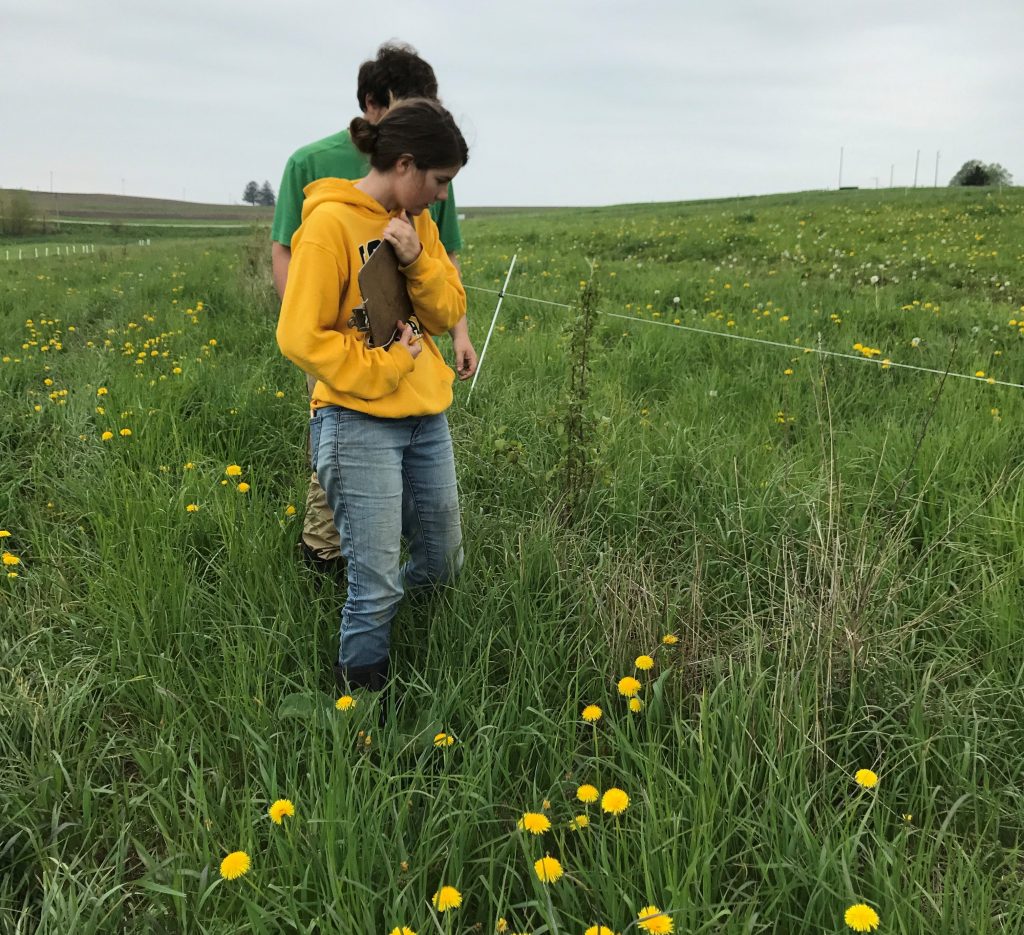
Figure 6: Photo of Michael Dolan and Chloe Park measuring weed height in a paddock protected by single-strand electric fencing. Notice the weed height makes it difficult to see trees. Photo by K. Gruley.
Green Fire Farm
Tree protection techniques tested were Tree Pro Miracle Tubes (hogs and sheep), Blue-X tree tubes (hogs and sheep), and Arbor Shields (hogs), and a no protection control (hogs). Electric net fence was used to partition paddocks by treatment. Arbor Shield cages were the best at protecting trees from damage by hogs (F3,16 = 15.3, p < 0.0001; Figure 7). Wire cages were the only mechanism that prevented damage, including tree height reduction, and was the only treatment in which all trees survived. Almost all other trees in the other three protection treatments died after hog grazing the first year.
Weed height within 1m of trees was reduced in all protection treatments post-grazing (Figures 7, 8). Arbor Shield wire cages showed the least reduction in weed heights closest to the tree/cages, increasing in height reduction with distance (Figure 7). Conversely, weed height was lowest closest to the trees in the unprotected and tree tube protection treatments after hog grazing and were higher with increasing distance from the tree/tube. These patterns demonstrate that the hogs were attracted to the unprotected trees and tree tubes and effectively repelled by the wire cages. Sheep also tended to graze down weed height more effectively closer to the tree tubes compared with distances farther out (Figures 7, 8).
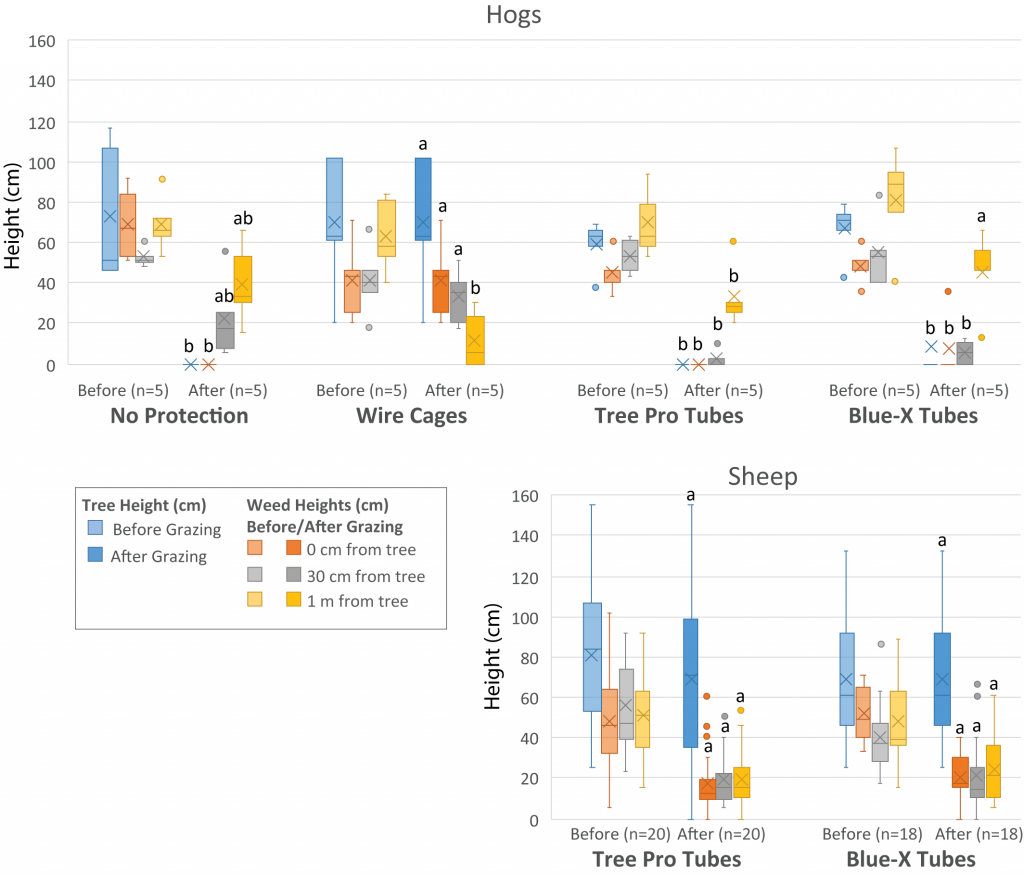
Figure 7: Tree height and weed height before and after hog and sheep grazing at Green Fire Farm in 2017. Weed heights were measured at 0, 0.3, and 1 m from tree. Tree protection treatments included a no protection control (hogs only), Arbor Shield wire cages (hogs only), 5’ Tree Pro Miracle Tubes, and Blue-X tree tubes. Response means that share a letter were not significantly different (one-way ANOVA with Tukey-Kramer post-hoc analysis at p < 0.05). Note that hogs resulted in nearly complete loss all trees with the exception of those protected by Arbor Shield cages. No sheep grazed in paddocks where control or Arbor Shield cages were used.
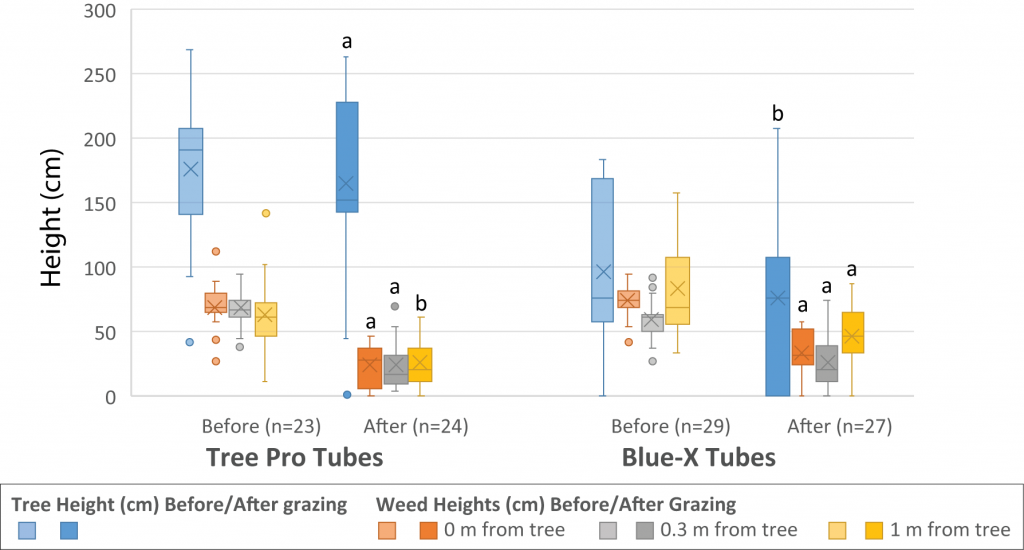
Figure 8: Tree height and weed height before and after sheep grazing at Green Fire Farm in 2017. Weed heights were measured at 0, 0.3, and 1 m from tree. Tree protection treatments for hogs were discontinued due to tree death in 2016. 2017 treatment data included 5’ Tree Pro tree tubes and Blue-X tree tubes for sheep. Response means that share a letter were not significantly different (t-tests at p < 0.05).
Farmer observations
Although tree height and weed height data showed no significant differences between Tree Pro tree tube and Blue-X tree tube protection treatments after sheep grazing in 2016, (Figure 7), 2017 data (Figure 8) and qualitative data based on exit interviews with the farmer provide some additional insight these into two treatments. Sheep were often able to knock over the tree tube protection and browse trees resulting in lower tree height post grazing events in 2017 (Figure 8). Sheep were often more inquisitive of the tree tubes initially and would browse the leaves and strip the bark rather than eating the pasture surrounding the trees. In general, Tree-pro tubes held up better to the livestock rubbing compared to Blue-X tubes, which sometimes folded like accordions, leading to more bark stripping. Hogs, on the other hand, would graze the silvopasture first before they became interested in the tubes to scratch or play. Hogs rubbed and scratched on the trees until the trees were knocked over, and then they would pull the trees out of the ground and perhaps browse the trees. Browsing the trees was secondary to rubbing and playing with the trees. After the second season of grazing, over 70% of trees protected by Blue-X tubes died, whereas less than 25% of trees protected by Tree-Pro tubes died (data not shown). Blue-X tubes also had sharper tops, so the wind tended to girdle trees once they were tall enough to grow out of the tubes (Table 6). Although not in the study, Marty found that 2-3 strands of single-strand electric fencing seemed to effectively keep both sheep and hogs away from the trees, especially when livestock were well-trained to this type of fencing.
In general, tree tubes were in constant need of being stood back up. Stakes are an important factor in success using tree tubes. The wooden stakes used at Green Fire Farm were difficult to pound more than a foot into the ground, so they were top-heavy. Thinner stakes were easier to get into the ground to deeper depths but were flimsier and easier for livestock to knock over. Once trees were knocked down, it seemed they were weaker to where wind would later knock the tubes/trees down. The farmer will likely use rebar or fiberglass stakes in the future that are driven into the ground by at least 18 inches.
Additionally, the 5’ Tree Pro tree tubes not only held up to livestock better but also did a good job of keeping away deer and voles. They seemed to create a good living environment for trees to thrive (assuming they remain standing). Average tree heights at the end of the second growing season for trees protected by 5’ Tree Pro tree tubes were 173.9 cm whereas the averages for Blue-X Tubes were 91.3 cm (Figures 7, 8).
Marty found the 45-foot spacing to work for sheep and hogs, however, more space would probably work better. If Marty could do it over, he would use 90 or 160 foot spacing for sheep and hogs and use square paddocks rather than narrow paddocks that followed keyline contours. Not only are the square paddocks more efficient for setting up portable fencing for rotational grazing, but it gives the animals more space between trees. With the 45 foot spacing, livestock were never more than 20 feet away from the trees, which may have led to more tree-livestock interaction. Additionally, planning for larger paddocks can accommodate more livestock if the goal is to grow that enterprise. Cattle, however, likely need even more space—at least 200- foot spacing. He encourages farmers to consider the purpose of silvopasture (e.g., commercial production from tree crops vs. livestock) in paddocks and silvopasture design.
Marty installed the protection after the trees were planted, which in retrospect was a mistake—they were hard to find when the weeds were high. In general, livestock varied with their responses to grazing in the silvopasture. Young livestock were more likely to trample the silvopasture than graze it. Hogs worked well with grazing as long as they could not access the trees, until it rained while they were in the silvopasture and were not able to be moved for a few days. Hogs tend to root and make the silvopasture very bumpy, so in the future, Marty plans to try to usinge hogs in long-term rotation, where hog grazing would be followed up with a cover crop for a year before planting another perennial pasture for sheep and cattle grazing.
After two additional grazing seasons have passed, approximately 30-40% of the trees remain. He is appreciative of his involvement in this project as a learning experience and plans to use what he learned to expand the silvopasture enterprise in the coming years.
Table 6: Costs and benefits of protection methods used at Green Fire Farm: Tree Pro tree tubes, Blue-X tubes, Arbor Shield Cages, and Electric polywire.
|
|
Tree Pro tree tube |
Blue-X tree tube |
Arbor Shield |
Electric polywire* |
|
Cost |
$4.05 per tree |
$4 per tree |
$29.77 per tree |
~$1 per foot |
|
Sturdiness |
Mostly |
Little |
Very |
Very |
|
Install time |
Quick |
Slow |
Very slow |
Quick |
|
Reusable |
Maybe? |
No |
Yes |
Yes |
|
Comments |
Rolled over edge at top prevents girding |
Flimsy, sharp top |
Potential injury to livestock, potential injury to people installing |
Weed height management; Energizer source, finding young trees in grass/weeds |
*Electric polywire was not employed as a tree protection treatment in this case study, but was used to separate paddocks.
Seven Sisters Farm
Protection methods for the newly established chestnut trees included Cobacha Arbor Shields, 4’ and 5’ Tree Pro Miracle tubes, and Tree Pro Bark Pro (2’). Chestnuts protected by the 4’ Tree Pro Miracle tubes were the tallest, averaging 155.1 cm, followed closely by the 5’ tubes (150.6 cm) and the 5’ Arbor Shields (148.7 cm) (Figure 9). Chestnuts protected by the 2’ Tree Pro Bark Pro were significantly shorter (F3,89 = 7.0, p < 0.001; Figure 9), averaging 103 cm and were the most heavily browsed—more than 90% of the chestnuts in this treatment had browsing damage (Table 7).
Stem growth data was not significantly different among the four treatments (Figure 9). Just over 10% of trees protected by the 5’ tubes had browsing damage, as did 40% of trees protected by Arbor Shields, and 60% protected by 4’ tubes. Browsing damage was significantly higher (χ2 (3, N = 93) = 35.07, p > 0.001) for trees protected by the 2’ Bark Pro tubes. Seven Sisters Farm hosts a very large wild deer population. Since the sheep grazing with the trees are much shorter, it is likely that any browse damage to trees in the 4’ and 5’ tubes was caused by deer rather than the sheep. Arbor Shields were found to work well as long as the tree is growing straight and does not lean against the cage. However, if they do lean against the cage, they are likely to undergo significant damage to the stems (Table 7). Approximately 75% of chestnuts protected by the Arbor Shield cages were damaged in this way.
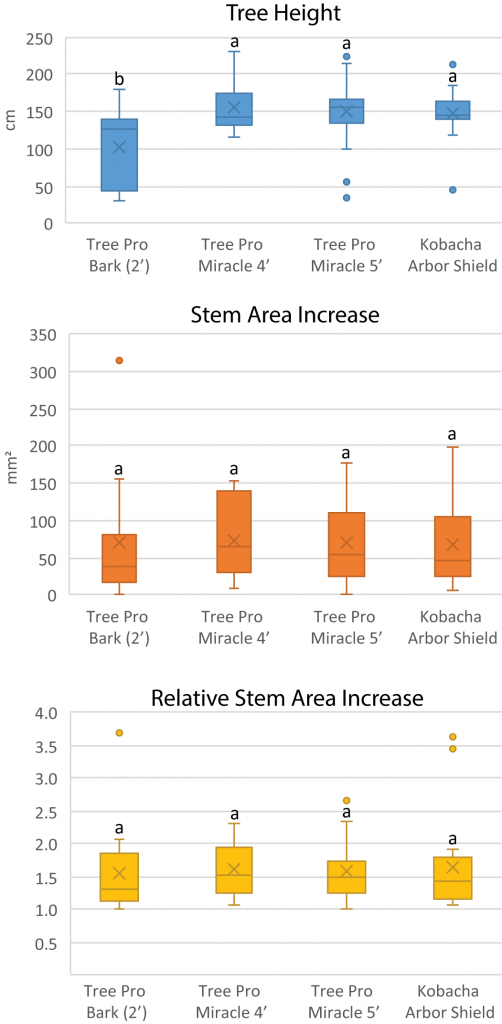
Figure 9: Tree height (cm), stem area increase (mm2), and relative stem area increase with sheep grazing at Seven Sisters Farm in 2016 for each of four tree protection treatments. Response means that share a letter were not significantly different (one-way ANOVA with Tukey-Kramer post-hoc analysis at p < 0.05).
Farmer observations
Some of the benefits found with the taller tree tubes is that they made mowing and weed management easier because the tubes made the trees easy to locate. Additionally, because the tubes did not have ventilation holes at their base, herbicide could be sprayed along the row without damaging the tree crops. However, insects can become an issue in the tubes. For example, if Japanese beetles get into a tree tube with a hazelnut inside, they are likely to totally defoliate the plant. Wasps also found the tree tubes habitable and can build nests in the tubes that are hard to detect. Additionally, chestnuts emerging out of the tubes commonly have trunks too weak to stand straight, so they often need to be staked to prevent rubbing of the trunk on the tube edge.
Along with protecting the trees from browsing damage, some argue that metal cages can force trees to develop trunk strength early on and become stronger. This result was not observed during the length of this study. Although data was not specifically collected on weed heights at this farm, weeds were more difficult to manage with the Arbor Shield protection treatment due to difficult access to the cage interior.
Currants, which were not protected, were completely defoliated by the sheep, and hazelnuts without protection were also heavily browsed. Interestingly, of the hazelnuts that were protected by tree tubes, shoots growing outside of the tubes were less likely to be browsed than shoots from unprotected trees. This could be due to noise/movement of the tree tube deterring deer and sheep away.
Table 7: Select damage prevalence data for each protection treatment as well as associated cost per protection unit and install time for Seven Sisters Farm.
|
Treatment |
n |
Damage Prevalence (%) |
Economics |
|||||||
|
Browse |
Bark |
Root |
Metal Rub |
Burrow |
Plant Heave |
Mouse Nest |
Cost per unit |
Install time per tree |
||
|
Tree Pro Bark Pro (2') |
16 |
93.8 |
18.8 |
0.0 |
0.0 |
0.0 |
18.8 |
0.0 |
$0.90 |
0:55 |
|
Tree Pro Miracle Tube (4') |
20 |
60.0 |
20.0 |
5.0 |
0.0 |
10.0 |
15.0 |
15.0 |
$3.35 |
1:15 |
|
Tree Pro Miracle Tube (5') |
37 |
10.8 |
8.1 |
0.0 |
0.0 |
10.8 |
8.1 |
16.2 |
$4.05 |
1:15 |
|
Kobacha Arbor Shield (5') |
20 |
40.0 |
35.0 |
5.0 |
75.0 |
25.0 |
0.0 |
0.0 |
$15.00 |
6:30 |
Educational & Outreach Activities
Participation Summary:
Accomplishments/Milestones:
In 2016, Cathe Capel and Michael Dolan each hosted a field day in August and September, respectively. Jacob Marty and Kevin Wolz (who is working with Cathy Capel on this project) presented on what they have learned so far in this study. Project coordinator Keefe Keeley presented initial results as part of presentations at the Silvopasture Camp that Savanna Institute co-hosted with UW and UMN cooperative extension as well as at the Hazelnut Growers Conference. We also developed a script and schedule to interview experienced farmers. Savanna Institute and partners created www.PerennialMap.org, which will host the silvopasture hub.
In 2017, Liz and Nate Brownlee and Jacob Marty hosted field days in May and October, respectively at each of their farms. Both the Brownlees and Jacob Marty presented preliminary results and their observations. Four interviews were completed between our farmers and experienced silovasturists. We also started compiling resources to be shared via the silvopasture hub as a part of www.PerennialMap.org.
We analyzed preliminary data at the beginning of 2017. Unsurprisingly, newly planted trees without protection were quickly decimated. Staked tree tubes were a good balance between time, money, and protection from smaller livestock. Arbor Shield metal cages or electric fencing are critical to protecting establishing trees from cattle.
We are currently working on finalizing data collection and analysis, editing interview recordings into podcasts, and launching the silvopasture hub.
Impacts and Contributions/Outcomes:
Combined attendance for the four field days was 230, and local media outlets covered two of the events. All farmers and the project coordinator discussed silvopasture, how it works at the farm, and what we are learning through these trials. Conference audiences for our presentations totaled approximately 220 people for 2016. We presented to over 300 people at various conferences, field days, and workshops in 2017.
Jacob Marty has shared some of his observations and results of the trials during an online webinar, hosted by the Savanna Institute, in which 38 people participated live, and the recording has been viewed 130 times to date. Jacob also presented at several conferences this winter. In addition, he and Nate Brownlee each talked about their respective trials at our Perennial Farm Gathering to more than 100 in attendance.
Generally, and perhaps most importantly, this project is helping develop a community of farms practicing silvopasture in the region. Each of these farms are gaining practical experience and knowledge in establishing silvopasture in a variety of different fashions, gathering knowledge from experienced farmers, and being equipped to share lessons learned with other farmers and interested people via on-farm events and media reaching an extended audience.
Learning Outcomes
Principles and practices of silvopasture
Project Outcomes
Our project worked intensively with four farmers to develop silvopasture establishment methods adapted to their respective pastured livestock operations. Through a variety of channels, we shared what we learned, and what has been been learned on other farms in the region. In terms of sustainability, silvopasture can offer improved livestock and pasture performance, added income from forest crops, and restored ecological functions.
Livestock performance in silvopasture systems has been a key question for researchers. Shade is one key factor. University studies in Kentucky, Missouri, and Arkansas have all shown increased weight gain in beef cattle that have access to shade. Studies in Florida and Virginia have shown increased milk production from cows that have shade. Two other studies in Florida and Missouri observed nearly twice the conception rate in beef cattle with shade compared to those without. Production losses due to heat stress can begin at temperatures as modest as 78 F. The university of MO has released a smartphone app called Thermal Aid that charts weather conditions and helps assess signs of heat stress in your herd.Winter shelter can also impact livestock performance. Animals without adequate shelter, especially from winter winds, require more feed to maintain body condition.
Pasture performance has also been the subject of silvopasture research. This research has aimed to test how forage quality, quantity, and availability is affected by trees within pastures. One potential benefit of silvopasture is less drastic of a slump in forage yield during summer months. Decreased production in shaded pastures during the spring flush can be a small price to pay for paddocks that continue to grow later in the year when open pastures go dormant.
It may not just be the shade that keeps the grass green under trees during droughts. Through a process called hydraulic lift, some deep-rooted trees actually bring water up from lower soil horizons, where it is used by neighboring plants. Although to date no one has reported hydraulic lift occurring in silvopastures, it has been documented in potential silvopasture tree genera such as pine and oak.
Studies have also shown improvements in forage quality under partially shaded conditions. Researchers at Iowa State showed in vitro digestible dry matter was 3-5% greater for grasses grown under partial shade, compared to those grown in full sun. Another study in Missouri showed higher protein and lower fiber content in annual ryegrass and cereal rye grown under a pine and walnut canopy, compared to treeless pasture controls. This study also showed that although cumulative forage production over several years was reduced by about 20% in the silvopasture, beef heifers grazed in the silvopasture showed no difference in gains than animals in the open pasture controls.
Many of these studies are from hotter parts of the country, where heat stress and summer pasture slump are more serious concerns. The climate extremes we are increasingly subject to in the upper Midwest suggest that we might do well to take lessons from folks in warmer, droughtier places.
Tree products
Growing trees with branchless tree trunks to make high-value sawlogs can be a challenge in silvopastures, given the partially open canopy. In natural forests and plantation, shade from neighboring trees inhibits branching. That said, after a thinning, large dominant trees grow fewer new branches than young and overtopped trees, and some research has shown that crop trees retained in maintained when establishing silvopasture this way maintain their timber value, and even increase their growth rate.
Planted trees intended for timber can also be trained to straight branchless growth via interplanting with fast-growing “nurse” trees. These nurse trees can be harvested early for many purposes, from pulp to firewood to mushroom inoculum. Leguminous nurse trees can also fertilize crop trees while being coppiced or browsed for fodder. Many “weed” trees like locust, box elder, and mulberry have leaves of high forage quality, making them potential candditates for the “dinner” rows of a hedge that protects and trains inner timber rows.
Silvopastures can also integrate human food production with fodder for livestock. Orchards that pasture fowl early in the season to eat insect pests or hogs to clean up after fruit harvest exemplify this stacked enterprise strategy. It is important to be aware of food safety regulations regarding livestock use and wastes where produce is grown, while also recognizing the potential of livestock as a tool in orchard sanitation and vegetation management.
Restoring ecosystem function
Silvopasture, when well-managed, can restore ecological features and functions to farm land. Besides biodiversity benefits, other potential gains in silvopasture ecosystem functions can be realized in nutrient cycling, soil conservation, and carbon sequestration in trees and soil, improved soil hydraulic function, and water quality. Globally, silvopasture has been ranked as the top agricultural practice in terms of potential to sequester atmospheric carbon by the team of scientists at Project Drawdown.
Thank you!
Information Products
- Agroforestry and Silvopasture in Illinois with the Savanna Institute (Multimedia)
- Silvopasture interviews (Website)
- Silvopasture Hub on PerennialMap.org (Website)
- Final Report: Protecting seedling trees and managing competing vegetation with livestock: cattle, sheep, hog, and poultry impacts on silvopasture establishment in four on-farm experiments in Midwest USA (Bulletin)
